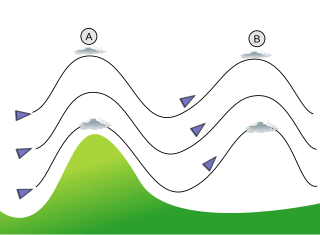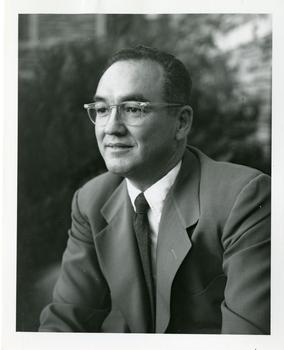Related Research Articles

Jean Felix Piccard, also known as Jean Piccard, was a Swiss-born American chemist, engineer, professor and high-altitude balloonist. He invented clustered high-altitude balloons, and with his wife Jeannette, the plastic balloon. Piccard's inventions and co-inventions are used in balloon flight, aircraft and spacecraft.

In meteorology, lee waves are atmospheric stationary waves. The most common form is mountain waves, which are atmospheric internal gravity waves. These were discovered in 1933 by two German glider pilots, Hans Deutschmann and Wolf Hirth, above the Giant Mountains. They are periodic changes of atmospheric pressure, temperature and orthometric height in a current of air caused by vertical displacement, for example orographic lift when the wind blows over a mountain or mountain range. They can also be caused by the surface wind blowing over an escarpment or plateau, or even by upper winds deflected over a thermal updraft or cloud street.
The Community Climate System Model (CCSM) is a coupled general circulation model (GCM) developed by the University Corporation for Atmospheric Research (UCAR) with funding from the National Science Foundation (NSF), the Department of Energy (DoE), and the National Aeronautics and Space Administration (NASA). The coupled components include an atmospheric model, a land-surface model, an ocean model, and a sea ice model. CCSM is maintained by the National Center for Atmospheric Research (NCAR).

In aeronautics, a balloon is an unpowered aerostat, which remains aloft or floats due to its buoyancy. A balloon may be free, moving with the wind, or tethered to a fixed point. It is distinct from an airship, which is a powered aerostat that can propel itself through the air in a controlled manner.

High-altitude balloons or stratostats are usually uncrewed balloons typically filled with helium or hydrogen and released into the stratosphere, generally attaining between 18 and 37 km above sea level. In 2013, a balloon named BS 13-08 reached a record altitude of 53.7 km.

The Columbia Scientific Balloon Facility (CSBF), established in 1961 and formerly known as the National Scientific Balloon Facility (NSBF), is a NASA facility responsible for providing launch, tracking and control, airspace coordination, telemetry and command systems, and recovery services for unmanned high-altitude balloons. Customers of the CSBF include NASA centers, universities, and scientific groups from all over the world.

Skyhook balloons were high-altitude balloons developed by Otto C. Winzen and General Mills, Inc. They were used by the United States Navy Office of Naval Research (ONR) in the late 1940s and 1950s for atmospheric research, especially for constant-level meteorological observations at very high altitudes. Instruments like the Cherenkov detector were first used on Skyhook balloons.

A superpressure balloon (SPB) is a style of aerostatic balloon where the volume of the balloon is kept relatively constant in the face of changes in ambient pressure outside the balloon, and the temperature of the contained lifting gas. This allows the balloon to keep a stable altitude for long periods. This is in contrast with much more common variable-volume balloons, which are either only partially filled with lifting gas, or made with more elastic materials. Also referred to as pumpkin or ultra long distance balloons (ULDB) balloons, the sealed balloon envelopes have a pumpkin shape at flight altitude.

In atmospheric science, an atmospheric model is a mathematical model constructed around the full set of primitive, dynamical equations which govern atmospheric motions. It can supplement these equations with parameterizations for turbulent diffusion, radiation, moist processes, heat exchange, soil, vegetation, surface water, the kinematic effects of terrain, and convection. Most atmospheric models are numerical, i.e. they discretize equations of motion. They can predict microscale phenomena such as tornadoes and boundary layer eddies, sub-microscale turbulent flow over buildings, as well as synoptic and global flows. The horizontal domain of a model is either global, covering the entire Earth, or regional (limited-area), covering only part of the Earth. Atmospheric models also differ in how they compute vertical fluid motions; some types of models are thermotropic, barotropic, hydrostatic, and non-hydrostatic. These model types are differentiated by their assumptions about the atmosphere, which must balance computational speed with the model's fidelity to the atmosphere it is simulating.

Walter Orr Roberts was an American astronomer and atmospheric physicist, as well as an educator, philanthropist, and builder. He founded the National Center for Atmospheric Research and took a personal research interest for many years in the study of influences of the Sun on weather and climate.

Malcolm David Ross was a captain in the United States Naval Reserve (USNR), an atmospheric scientist, and a balloonist who set several records for altitude and scientific inquiry, with more than 100 hours flight time in gas balloons by 1961. Along with Lieutenant Commander Victor A. Prather (USN), he set the altitude record for a manned balloon flight.
In models of radiative transfer, the two-stream approximation is a discrete ordinate approximation in which radiation propagating along only two discrete directions is considered. In other words, the two-stream approximation assumes the intensity is constant with angle in the upward hemisphere, with a different constant value in the downward hemisphere. It was first used by Arthur Schuster in 1905. The two ordinates are chosen such that the model captures the essence of radiative transport in light scattering atmospheres. A practical benefit of the approach is that it reduces the computational cost of integrating the radiative transfer equation. The two-stream approximation is commonly used in parameterizations of radiative transport in global circulation models and in weather forecasting models, such as the WRF. There are a large number of applications of the two-stream approximation, including variants such as the Kubelka-Munk approximation. It is the simplest approximation that can be used to explain common observations inexplicable by single-scattering arguments, such as the brightness and color of the clear sky, the brightness of clouds, the whiteness of a glass of milk, and the darkening of sand upon wetting. The two-stream approximation comes in many variants, such as the Quadrature, and Hemispheric constant models. Mathematical descriptions of the two-stream approximation are given in several books. The two-stream approximation is separate from the Eddington approximation, which instead assumes that the intensity is linear in the cosine of the incidence angle, with no discontinuity at the horizon.

Joachim Kuettner, also spelled Küttner, was a German-American atmospheric scientist.
Paul Rowland Julian, a Fellow of the American Meteorological Society, is an American meteorologist who served as a longtime staff scientist at the National Center for Atmospheric Research (NCAR), was co-author with Roland Madden of the study establishing the Madden–Julian oscillation (MJO), and contributed to the international, multi-institutional Global Atmospheric Research Program (GARP), Tropical Wind, Energy Conversion, and Reference Level Experiment (TWERLE), and Tropical Ocean-Global Atmosphere (TOGA) meteorology research programs. The MJO meteorologic phenomenon he co-discovered is the largest element of the intraseasonal variability in the tropical atmosphere, a traveling pattern arising from large-scale coupling between atmospheric circulation and tropical deep convection. Description of the MJO remains an important contribution to climate research with relevance to modern short- and long-term weather and climate modeling.

Vincent E. Lally received a B.S. in Meteorology from the University of Chicago in 1944. After service in the Pacific as a meteorologist and radar officer in the Army Air Corps, Lally returned to M.I.T. where he received the degrees of B.S. in Electrical Engineering in 1948 and M.S, in Engineering Administration in 1949. From 1951 to 1958, he worked at the Geophysics Research Directorate of the Air Force Cambridge Research Center where he was the leader of the meteorological equipment development program for the Air Force. From 1958 to 1961, he was manager of research at Teledynamics, Inc., and then accepted appointment at the newly formed National Center for Atmospheric Research (NCAR) as Director of the National Scientific Balloon Facility. In 1965, he established the Global Atmospheric Research Program (GARP) to develop long-duration balloons.
Margaret Anne LeMone is an atmospheric scientist who uses both atmospheric observations and computer models to study the formation and development of clouds, the development of precipitation, and the structure of storms.
Roland Aloysius Madden, an American meteorologist, was a staff scientist at the National Center for Atmospheric Research (NCAR) from 1967 to 2002. His research centers on diagnostic studies of the atmosphere. Madden is a fellow of the American Meteorological Society (AMS) and a recipient of the 2002 Jule G. Charney Award of the AMS.

Vera Simons (1920–2012) was an inventor, artist, and balloonist. She became known in the 1950s and 1960s as a leader in high altitude gas balloon development and exploration, belonging to a group of pioneers known as the "Pre-Astronauts."

Project NIMROD was a meteorological field study of severe thunderstorms and their damaging winds conducted by the National Center for Atmospheric Research (NCAR). It took place in the Greater Chicago area from May 15 to June 30, 1978. Data collected was from single cell thunderstorms as well as mesoscale convective systems, such as bow echoes. Using Doppler weather radars and damage clues on the ground, the team studied mesocyclones, downbursts and gust fronts. NIMROD was the first time that microbursts, very localized strong downdrafts under thunderstorms, were detected; this helped improve airport and public safety by the development of systems like the Terminal Doppler Weather Radar and the Low-level windshear alert system.
Elizabeth Cicely Ridley was a British-American applied mathematician known for her work in numerical quantum chemistry and in climate modeling. The Roble–Dickinson–Ridley code that she and her collaborators created at the National Center for Atmospheric Research was the first general circulation model of the thermosphere.
References
- 1 2 3 4 5 "GHOST program". The Illustrated Encyclopedia of Aviation and Space. Vol. 6. Los Angeles: A.F.E. Press. 1971. pp. 978–979. LCCN 68014013.
- 1 2 Frykman, Robert W; Vincent E Lally (1971). "A carrier balloon for tropical soundings". NCAR Tech Note. TN/EDD-63.
- ↑ Voss, Linda. "Ballooning and Meteorology in the Twentieth Century". U.S. Centennial of Flight Commission. Archived from the original on 2007-10-21. Retrieved 2007-10-17.
- ↑ Hosanky, David (April 2004). "UCAR Staff Notes: Kaye Howe wins YWCA award". UCAR Communications, Staff Notes Monthly. University Corporation for Atmospheric Research. Archived from the original on 2008-05-17. Retrieved 2007-10-17.
- ↑ Lally, Vincent E (1970). "Superpressure Balloon Flights from Christchurch, New Zealand, July 1968 - December 1969". NCAR Tech Note. TN-48.
- ↑ Lally, Vincent E (1969). "Superpressure Balloon Flights from Christchurch, New Zealand August 1967 - June 1968". NCAR Tech Note. TN-38.
- ↑ Lally, Vincent E (1968). "Superpressure Balloons for Horizontal Soundings of the Atmosphere". NCAR Tech Note. TN-28.
- ↑ "Winzen Award Recipient - 2003". American Institute of Aeronautics and Astronautics. Archived from the original on 2007-10-21. Retrieved 2007-10-17.
- ↑ Hosansky, David (March 2003). "Vin Lally wins prestigious ballooning award". UCAR Communications, Staff Notes Monthly. University Corporation for Atmospheric Research. Archived from the original on 2006-09-11. Retrieved 2007-10-17.